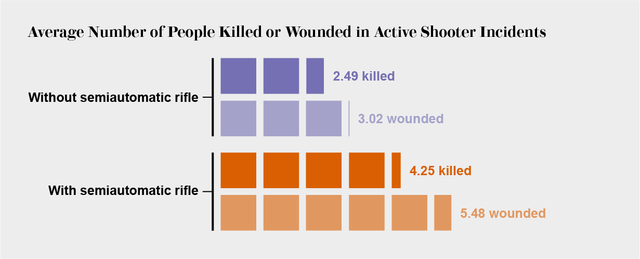Data Confirm Semiautomatic Rifles Linked to More Deaths, Injuries

If a shooter uses a semiautomatic rifle instead of another type of gun, it appears to roughly double the chances of victims being wounded and killed.
Researchers at Brigham and Women’s Hospital (BWH) came to this conclusion about “active shooters”—people who attempt to kill or hurt others with a gun in a populated area—in a paper published Tuesday. The work analyzed more than 200 such incidents in the U.S.
A 1994 federal assault weapons ban prohibited manufacturing, transferring or possessing certain semiautomatic firearms for civilian use. But that legislation expired in 2004, and gun control advocates have since been lobbying hard to reintroduce such limitations alongside other more expansive gun reform.
Semiautomatic rifles, which include assault weapons like the AR-15 and its variants, are relatively easy to operate and capable of firing very quickly. They can be used with large magazines and high-velocity ammunition, and are infamous for causing egregious damage to soft tissue and bone. In recent years mass shooters wielded them in Aurora, Colo., Orlando, Fla., and Newtown, Conn., among other places. Yet there had been no comprehensive assessment of injuries from the different types of firearms used in such situations, notes Adil Haider, a trauma and critical care surgeon who directs the Center for Surgery and Public Health at BWH. He and his colleagues aimed to address that gap in their study, published in JAMA The Journal of the American Medical Association. “The biggest take-home message is that in an active shooter incident, an assailant with a semiautomatic rifle may be able to hurt and kill about twice the number of people compared to if they had a non-semiautomatic rifle or a handgun,” he says.
The new study from Haider and colleagues compares the number of people hurt or killed in 248 active shooter incidents from 2000 through 2017, using FBI data. The scientists cross-referenced those incidents with court records and media reports to determine whether the weapon was a semiautomatic rifle. They found about a quarter of all those shootings involved such weapons whereas the rest involved handguns, shotguns and non-semiautomatic rifles. In total, these shootings wounded almost 900 people and killed more than 700.
The researchers’ records do not include every shooting with mass casualties during that 17-year period, and the definition of “active shooter” may have missed instances of gang violence, Haider says. The JAMA analysis also did not include situations with multiple shooters or extremely large death tolls because these would skew their results, Haider says. “We wanted to make sure we were comparing like with like incidents to truly get at the question about injuries and deaths from semiautomatic rifles versus other guns with a single active shooter,” he says.
The analysis found a shooting involving a semiautomatic rifle was associated on average with five injuries versus three if a different kind of gun was used. Similarly, the presence of the semiautomatic rifle was associated with four deaths instead of two.

Credit: Amanda Montañez; Source: “Lethality of Civilian Active Shooter Incidents with and without Semiautomatic Rifles in the United States,” by Elzerie de Jager et al., in JAMA The Journal of the American Medical Association, Vol. 320, No. 10; September 11, 2018
When people were injured with semiautomatic firearms as compared with other types of guns, however, it appeared the proportion of people who eventually died was roughly equal—leading to fatalities around 44 percent of the time regardless of weapon used. Haider attributes the similar rate to the fact that in each of these incidents an active shooter would likely be shooting at close range in a confined space. Although death rates were similar when people were shot, he says, semiautomatic rifles would increase the chance of getting hit at all.
Using the FBI database of active shooters underrepresents mass shootings and other public shootings, says Philip Cook, a professor at the Sanford School of Public Policy at Duke University who was not involved with the JAMA paper. He also believes the new BWH work has limited policy applications, because it looks at all semiautomatic rifles—instead of limiting the study to “assault weapons” as defined in the 1994 legislation. From a policy perspective, he says, “The possibility of banning all semiautomatic rifles is nil, since they are such a common type of rifle.”
The FBI did not immediately respond to a request for comment, but the agency has previously defined “mass shootings” as incidents with several fatalities—thus not all active shooting incidents would qualify as mass shooting events. The FBI has also said it excludes shootings that resulted primarily from gang or drug violence from its active shooter reports.
Hi! I am a robot. I just upvoted you! I found similar content that readers might be interested in:
https://www.scientificamerican.com/article/data-confirm-semiautomatic-rifles-linked-to-more-deaths-injuries/